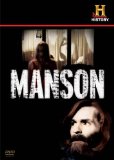| Reviews & Columns |
|
Reviews DVD TV on DVD Blu-ray 4K UHD International DVDs In Theaters Reviews by Studio Video Games Features Collector Series DVDs Easter Egg Database Interviews DVD Talk Radio Feature Articles Columns Anime Talk DVD Savant Horror DVDs The M.O.D. Squad Art House HD Talk Silent DVD
|
DVD Talk Forum |
|
|
| Resources |
|
DVD Price Search Customer Service #'s RCE Info Links |
|
Columns
|
|
|
Manson: 40 Years Later
If the Woodstock Music Festival in the summer of 1969 represented the pinnacle of the Sixties' flower-children movement, then the Manson Family killings, which occurred a week earlier, marked the darkest and ugliest recesses of the counterculture. Led by Charles Manson, the quasi-commune lived in an abandoned movie lot about 25 miles outside of Los Angeles, where they listened to music, dropped acid, held orgies and eventually committed murder. It's a real-life horror story chronicled in the new made-for-TV docudrama, Manson.
The tale of Charles Manson and the Tate-LaBianca murders has been recounted innumerable times over the past 40 years, but Manson the movie has at least one relatively novel spin. The picture, which recently aired on The History Channel, benefits from the on-screen recollections of Linda Kasabian, a former Manson acolyte who testified in court against her old chums. Kasabian served as lookout in the Aug. 8, 1969, attack that ended with the grisly slayings of actress Sharon Tate and four others. Kasabian's story adds a chilling perspective to the proceedings. The film unfolds with the self-professed "flower child," portrayed by Tamara Hope, on a journey for spirituality. "I was searching for love and freedom," she says in voiceover. "I was searching for God."
Instead, Kasabian and her young son found the Manson "family" and its wild-eyed leader, a man affectionately known to his followers as "Charlie."
More dramatization than conventional documentary, Manson just barely walks the tightrope between semi-respectable docudrama and exploitation flick. Director Neil Rawles weaves re-enactments with voiceover narratives from the likes of Kasabian; former Manson follower Catherine "Gypsy" Share; Tate's sister, Debra Tate; and ex-Los Angeles County prosecutor Vincent Bugliosi, who successfully prosecuted Manson and his underlings for the Tate-LaBianca murders.
Viewers with only a cursory knowledge of this sordid chapter in true crime will likely find much of it fascinating. Manson, an aspiring songwriter, had a brief friendship with Beach Boys drummer Dennis Wilson, who, in turn, let the Manson Family hang out at his home on Sunset Boulevard for long stretches. Wilson also introduced Manson to record producer Terry Melcher and other music industry executives.
Manson even went on to audition for Melcher, but was given the brush-off treatment. It is not coincidence that Melcher, the son of Doris Day, briefly lived at 10050 Cielo Drive, the L.A. residence that later would be inhabited by movie director Roman Polanski and his young bride, Sharon Tate.
Manson posits that Charles Manson's rage against the Establishment was stoked by his inability to break into show business, and that he perhaps wrongly believed Melcher still lived at the Cielo Drive address the evening of Aug. 8, 1969. That night, Manson dispatched four of his followers -- Kasabian, Tex Watson, Susan Atkins and Patricia Krenwinkel -- to massacre anyone at that house.
They did as they were told. Over two nights, the Manson Family killed seven people. The first night's victims included Tate, who was eight and a half months pregnant; Wojciech Frykowski and his girlfriend, coffee heiress Abigail Folger; hairstylist Jay Sebring; and Steve Parent, a friend of the estate's caretaker.
The Manson Family struck again the following night. Manson, Watson, Atkins, Kasabian, Krenwinkel and two others -- Clem Grogan and Leslie Van Houten -- entered the home of grocery store executive Leno LaBianca and his wife, Rosemary. Van Houten would later say that the more she stabbed Rosemary LaBianca, the more "fun" it was. In the end, the couple was stabbed nearly 100 times. The mind-numbing brutality of the Tate-LaBianca killings is emphasized by the film's use of real crime-scene photographs.
The aforementioned photos, in fact, are one of the few times that Manson truly conveys the horror of the Tate-LaBianca murders. The movie's Catch-22 is that it offers little insight into either Charles Manson or what led a group of seemingly average 20-somethings to follow his command.
Consequently, Manson will mainly interest viewers who don't know much about the story. But chances are that anyone intrigued by the subject matter has already read either the Bugliosi book, Helter Skelter, or seen the 1976 made-for-TV movie of the same name.
The re-enactments are competently staged, but it's doubtful whether they add much to one's understanding of the Manson Family and their crimes. The acting is certainly fine. Hope lends some hippie-dippy naïveté to Linda Kasabian. Adam Wilson, who portrays Manson, is adequate but falls short of registering the killer's warped charisma. Perhaps, too, the actor falters in the shadow of Steve Railsback's iconic performance as Manson in Helter Skelter.
The DVDThe Video:
For a nonanamorphic image, the picture is otherwise solid, with strong lines, rich colors and inky blacks.
The Audio:Dolby Digital 2.0 is serviceable, but unremarkable. Sound is clean and dialogue is clear. Unfortunately, no other language tracks or subtitles are available.
Extras:None.
Final Thoughts:Manson is a well-crafted docudrama that hits on the key points of the Charles Manson saga, but its failure to delve deeper into the story might leave true-crime buffs wanting more.
|
| Popular Reviews |
| Sponsored Links |
|
|
| Sponsored Links |
|
|
| Release List | Reviews | Shop | Newsletter | Forum | DVD Giveaways | Blu-Ray | Advertise |
|
Copyright 2024 DVDTalk.com All Rights Reserved. Legal Info, Privacy Policy, Terms of Use,
Manage Preferences,
Your Privacy Choices | |||||||














